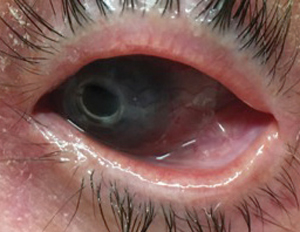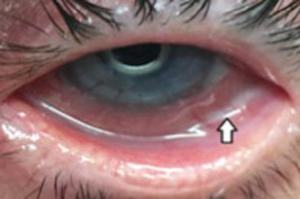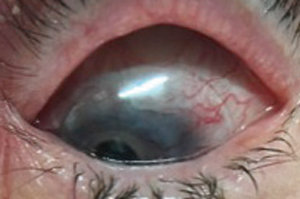 |
After a Boston keratoprosthesis (KPro) implantation, many patients are prescribed extended-wear soft contact lenses to protect the cornea and minimize complications such as infections, epithelial defects and stromal melt.1 However, these lenses are usually standard for every patient, and clinicians do not evaluate the fit. One study found that merely five out of 16 patients actually fit the standardized bandage lens size (9.6mm/16.0mm diameter) typically used for patients following surgery.2 We at UCLA use traditional silicone hydrogel contact lenses to minimize hypoxia for patients who need bandage lenses. But sometimes, we need a customized lens to achieve the best fit.
Case
An 81-year-old female presents for a contact lens fitting, referred by her ophthalmologist. She had a history of bullous keratopathy in both eyes after cataract surgery 15 years ago. She also suffered from limbal stem cell deficiency, which led to multiple failed corneal transplants, ultimately resulting in Boston KPro surgery for the right eye in 2013 and in the left eye in 2016. She had complaints of extreme photophobia, tearing and pain. She suffered from persistent epithelial defects in the left eye after her surgery. To treat the epithelial defects, a bandage contact lens was placed on her left eye. Although this bandage lens alleviated her pain, it was difficult to insert and popped out of her eyes constantly. She was not able to put them in herself and would have to travel several hours to come into the clinic to replace the lenses. She suffered severe pain when the lens dislodged, and she was unable to keep her eye open when the lens was out.
 |
| Fig. 1. The patient’s inferior symblepharon in the left eye made a standard bandage lens dislodge. |
Current ocular medications were Vigamox (Novartis) TID OU and prednisolone acetate BID OS. Presenting uncorrected visual acuity was 20/200 OD, 20/200 OS. Manifest refraction was plano OD and -2.50 VA: 20/100 OS. She had +5.00 add J3 OU.
Slit lamp exam revealed blepharitis in both eyes, slight medial and lateral tarsorrhaphy OS, superior and lateral symblepharon in both eyes with trace injection OS (Figure 1). The KPro in both eyes had vascularization and scarring of the donor cornea, no current epithelial defect in either eye with 16 sutures per eye. Anterior chambers were deep and quiet, and the iris was normal with posterior chamber intraocular lenses in both eyes. Intraocular pressure was soft and equal by palpation in both eyes.
Contact Lens Fitting
The cornea division first tried an Acuvue Oasys (Johnson & Johnson Vision) 8.4 base curve/14.0 diameter bandage lens. It was apparent that the limiting factors in finding the right lens were the size of the patient’s eye and the symblepharon. An Air Optix Night and Day (Alcon) 8.4 base curve/13.8 diameter was tried on the eye which was a slightly smaller diameter than the Acuvue lens. The lens was difficult to insert and promptly ejected when the patient gazed medially—the symblepharon was pulled taut, which lifted the lens straight off of the eye. We decided a custom diameter soft lens was necessary to properly fit the eye. Keratometry readings could not be obtained for a Boston KPro. Thinking outside the box, we used a 13.0mm color-coded diagnostic soft lens fitting set that is normally used to fit children (Figure 2). An 8.4mm/13.0mm diameter lens, although still too large, was the best fit.
We ordered a 8.3/-2.50/12.5 diameter soft lens in Definitive (Contamac) material with a slightly steeper base curve to compensate for the 0.5mm change in diameter.
 |
| Fig. 2. This color-coded soft lens diagnostic 13.0mm fitting set helped us custom-fit a better lens option for our patient. |
One Week Later
The patient presented for the bandage lens dispense. She had spent most of the week with her eyes closed due to the pain, for which she was taking Tylenol (Johnson & Johnson). Unlike the previous attempts, the lens was easily placed on the eye and evaluated. The lens was centered and fit the KPro nicely (Figure 3). The edge of the lens rested next to, but not over, the symblepharon, which was ideal to improve the stability of the fit. The patient was sent home with instructions to return if the lens fell out.
Two Weeks Later
The patient returned for a follow up. She was unaware if the lens was still in her eye, but said she had less pain in the past few weeks. She reported a slight foreign body sensation on lateral gaze that was tolerable. On examination the lens was in place. The lens fit was finalized and more lenses were ordered as spares. Since the patient was unable to insert and remove the lenses on her own and had no one to help her, she returned monthly for bandage lens replacement and corneal evaluation.
 |
 |
| Fig. 3. The custom bandage lens in place. The arrow in the top image indicates the lens edge. The bottom image provides a superior view of the lens. |
Six Months Later
At six months, the patient was still doing well. Only one lens was lost in that span of time, which was a significant improvement for her.
Discussion
KPro is a treatment option for patients with corneal disorders who have failed multiple corneal transplants. Ideal candidates are those who have had repeat corneal graft failures and do not have severe inflammation, as it increases the risk for necrosis and infection.3-7
Clinicians must pay particular attention to patients with corneal transplants to reduce neovascularization that could lead to a corneal graft rejection or failure, especially when fitting contact lenses. According to one study, extended wear for the normal cornea requires a Dk/t of 87, and not meeting that threshold can lead to corneal hypoxia in the form of corneal edema or neovascularization.8-11
However, this is not a concern for KPro recipients.12 The donor tissue of the KPro is vascularized, negating the concern for oxygen delivery. Nonetheless, the hypoxic environment can increase the chance of microbial infection, which is why most patients with a KPro implant are on preventative long-term antibiotic therapy, antifungal therapy and close observation.
When traditional bandage lenses fail to fit the patient, clinicians should consider customizing silicone hydrogel lenses using Definitive material, which has the highest Dk available—60Dk—for this type of lens. Such customization can help improve the patient’s experience while also minimizing hypoxia.
1. Kammerdiener L, Speiser J, Aquavella J, et al. Protective effect of soft contact lenses after Boston Keratoprosthesis. Br J Ophtlalmol. 2015;100(4):1-4.
2. Theodossiades J, Shah S, Wilkins M. Improving bandage contact lens fits in Boston keratoprosthesis patients. Presented at ARVO Meeting, 2014.
3. Dohlman CH, Dudenhoefer EJ, Khan BF, et al. Protection of the ocular surface after keratoprothesis surgery; the role of the soft contact lens. CLAO J. 2002;25:72-4.
4. Nouri M, Terada H, Alfonso EC, et al. Endophthalmitis after keratoprothesis incidence, bacterial causes, and risk factors. Arch Ophthalmol. 2001;119:484-9.
5. Yaghout F, Nouri M, Abad JC, et al. Keratoprosthesis preoperative prognostic categories. Cornea. 2001;20:19-23.
6. Chan C, Holland E. Infectious keratitis after Boston Type 1 keratoprosthesis implantation. Cornea. 2012;31(10):1128-34.
7. Chan C, LoVerde L, Qiang J, et al. Incidence, risk factors and surgical management of Boston type 1 keratoprothesis melts, leaks, and extrusions. Cornea. 2016;35(8):1049-1056.
8. Holden BA, Mertz GW. Critical oxygen levels to avoid corneal edema for daily and extended wear contact lenses. Invest Ophthalmol Vis Sci. 1984;25:1161-7.
9. Holden BA, Williams L, Zantos SG. The etiology of transient endothelial changes in the human cornea. Invest Ophthalmol Vis Sci. 1985;26:1354-9.
10. Papas EB. The role of hypoxia in the limbal vascular response to soft contact lens wear. Eye & Contact Lens. 2003;29:S72-4.
11. Holden BA, Sweeney DF, Vannas A, et al. Effects of long-term extended contact lens wear on the human cornea. Invest Ophthalmol Vis Sci. 1985;26:1489-501.
12. DeNaeyer G. Minimizing corneal graft rejections. Contact Lens Spectrum. September 2009.


